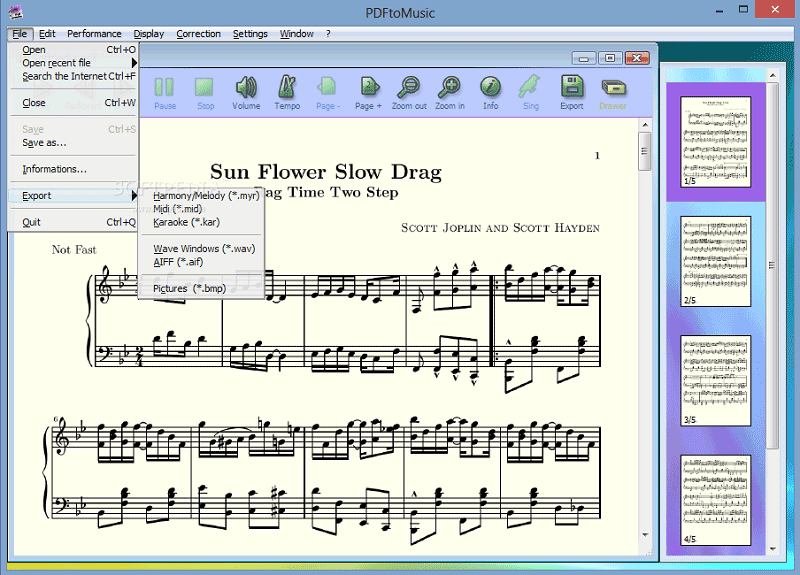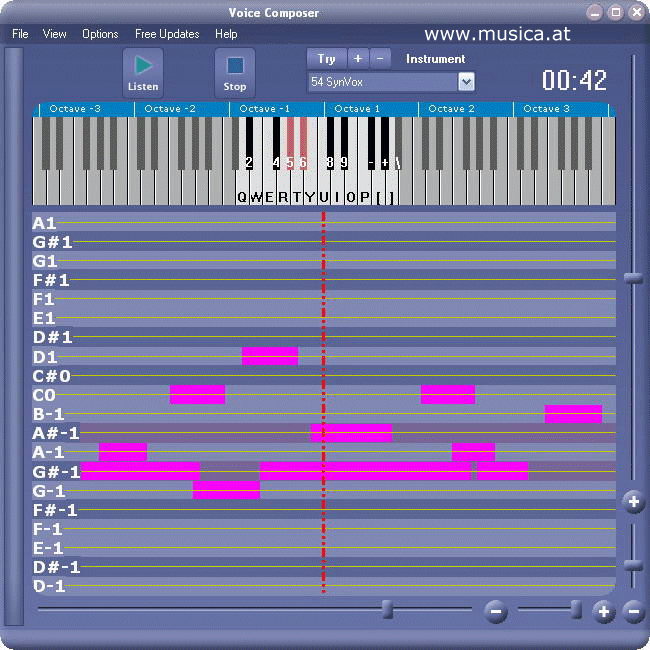
On closer examination, they were all the same error, telling me that the name "Strings" did not exist in the current context.
#Sheet music to midi converter software#
I used VS, after having tried to build the software from the command line, as prescribed in the README file, and failing.Īctually it took me a while to get the package to build without errors, first I got 100 errors. Open the project in Visual Studio, and build an EXE-file. Actually, I don't understand how this method works, as far as I can see, it's never called on elsewhere in the Piano.cs file. Of course you can change it to any color you like, or use a hexadecimal value, if you prefer.

Open the file Piano.cs in an editor (I used Notepad ++) and find the method SetShadeColors.Īdd the following, as the first line in the method (or at least before the variable c1 is used:)Ĭ1 = Color.FromKnownColor(KnownColor.Lime) Obviously the first step is downloading the source code, since this involves building the software from scratch. I actually worked out a solution for this, and would like to post it, in case anyone else, using this program, is finding the light grey color hard on the eyes. It doesn't seem to have support for ties, which may be the reason for the incorrect length (type) of notes being shown.įor those of us (like myself) whose eyser aren't what they used to be, the light grey color of the notes for the treble clef, when they are shown on the piano, is a bit hard to see. It doesn't always show the correct length of notes. Though it is quite good overall, there are a few minor flaws. I did the mix, he did the transcription from audio to MIDI.First I'd like to thank you for writing this software, and making it available for free, as well as open source.

all played at once into a single 16-channel MIDI device ( Yamaha XG MU100, circa 1997), the stereo output recorded untouched. I realised I have one of his transcriptions already on Soundcloud - this is a MIDI file, a "one box demo" i.e. I do know one guy who can transcribe an orchestra, vertically, down the page, in 2-bar segments, pausing the audio only long enough for him to physically write all the notes. I know many people who can transcribe accurately with little repetition, though mostly they listen to one instrument at a time. It's too old to have ever made it to YouTube, so I can't demonstrate how it did actually work - even in a rather primitive way. Pitch tracking itself has come a long way over the years.īack in the late 90's I worked for Yamaha R&D & we were truly proud at that time to be able to play midi drums & piano, whilst live-tracking a real bass guitar, audio to midi, & sync that all to a streamed vocal recording, with a video of the entire performance, as a kind of 'simulcast'. Yes, it sounds truly weird :\ but if you didn't know the original, I doubt you would be able to tell what had been done to it. Whether it can convert this, without error, into MIDI would be a whole different level of task, & one I have never actually needed to test. With audio, you can then shift pitches within the file without changing the entire song. Melodyne is about the only commercially-available software than can analyse chords & separate the pitches. I own the software & have done for a decade The manufacturer, Celemony, have a scant entry on Wikipedia but you can investigate Melodyne on their own site.

To the uninitiated - Melodyne is "Auto Tune" on steroids. fine, but that's not MIDI, that's Melodyne live-shifting one single note from the chord as audio, in realtime He's done the multi-pitch analysis, & is then dragging notes up & down. I had a quick listen to part of the YouTube video - they guy is confusing audio & MIDI a bit, really.


 0 kommentar(er)
0 kommentar(er)
